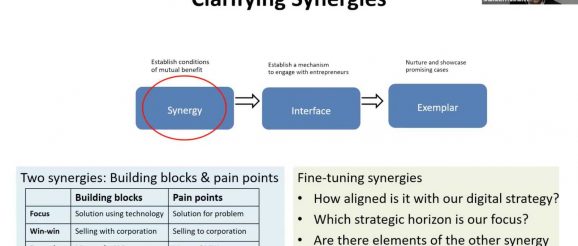Gorillas Can Dance: Cultivating Effective Startup Partnerships to Foster Corporate Innovation – Innov8rs

Faced with disruption, large corporations are realizing the value of partnering with start-ups. However, while this could result in win-win collaborations, developing productive partnerships is not straightforward.
The very thing that attracts them to each other – their significant differences – also makes it difficult to work together. Therefore, the partnering process must address multiple asymmetries by focusing on the three facets of synergy, interface, and exemplar.
Drawing upon over a decade of research in multiple locations – including China, Germany, India, Israel, UK and USA – Professor Shameen Prashantham recently joined us for Innov8rs Connect on Startup Collaboration and Ecosystem Engagement, to provide guidance on the “why”, “how” and “where” of corporation-start-up partnering.
As or With?
The idea of managers acting as entrepreneurs is common throughout the world of business. IBM’s CEO, Arvind Krishna, recently explained to his employees that their focus had to cultivate an entrepreneurial mindset throughout the business.
However, managers with entrepreneurs is a better approach for cultivating innovation. Intrapreneurship, with internal, learning-driven approaches can work well. But it’s inherently difficult for large organizations to develop the same incentives and flexibility that entrepreneurs tend to have in great supply.
So, instead of big companies trying to be more entrepreneurial themselves, they should instead think about partnering up with external entrepreneurs. While you can partner without investing, you can’t invest without partnering.
Initiation, Expansion and Systematizing
The safe option for corporations is to partner with other big companies. Whether or not they share the same core values, it’s just easier to pair up with another business that has already proven itself.
Corporations may perform pilot experiments, but it’s hard to scale these. In order to do so, there is a painful learning process and a lot of genuine effort required. Corporates must first initiate the partnership, but that’s the easy part.
They then need to collaborate with the entrepreneurs and win their hearts and minds. They can then refine their strategy and make adjustments on the way as they go through the expansion phase.
Finally, they must systematize. They do this by integrating the partnership with corporate innovation, culture and strategy. In order to get past the experimental phase, alignment is key across the board.
Paradox of Asymmetric Partnering
Partnering up with entrepreneurs is no straightforward process. The differences between startups and big corporations that make them so attractive to each other can also make it more difficult for them to work well together.
Asymmetry of Goals
While the startups lack the resources of the big corporations, they have the passion and drive needed for innovation. But these differences can make it hard to work together effectively. Working towards different goals and time horizons leads to an initial asymmetry.
Structural Asymmetry
Structural asymmetry is a clear barrier towards growth too. And so, both parties must be willing to adapt to accommodate the structural requirements of the other to make the partnership work.
Asymmetry of Attention
Finally, there is also asymmetry of attention. The large corporation might see plenty of startups around them to choose from. They then might have a tough time deciding which ones are most promising.
On the other hand, the startup might see the company they want to work with very clearly. But they need to fend off the many startups around them that are in direct competition with them for that company’s attention. Only when these three asymmetries are at their least prominent can a partnership between a corporation and a startup bear fruit. But careful management is also key.
Carefully Managed Partnering Process
There are three elements to every successful partnership between an entrepreneur and a big corporation. The first of these is synergy. This involves establishing conditions of mutual benefit, so that it’s a win-win relationship from the start.
The next aspect of a successful partnership is the interface between both parties. This involves finding the balance between using groups of startups or screening out just one or two to pair up with.
Finally, the aspect of exemplar involves attracting high quality startups and persuading internal audiences of the right directions in which to take the partnerships. Prioritizing the attention within the partnership, along with managing risk are two key drivers of success.
Different Locations Need Different Approaches
The “Where?” is just as important as the “Why?” and the “How?” when it comes to fostering successful entrepreneurial partnerships. By grouping markets into advanced or emerging, and deciding whether they are of low or high reputation, a sweet spot (or several sweet spots) can be found for many industries.
In a low reputation emerging market, there might be a lot of passionate entrepreneurs to work with. But the corporation must understand that there might be a lot of handholding at the start, as the startup may lack experience or resources.
In an advanced market with a high reputation, the level of quality of the startups in terms of their financial and experiential shape might be higher. However, this may come with a larger financial and opportunity cost, as the entrepreneurs might have a more refined and less flexible approach.
Remaining aware of key opportunities across these markets is key. Various financial crises, and more recently the COVID-19 pandemic, have shown that distress on a global scale can lead to large amounts of social investment. This in turn can foster entrepreneurship in emerging markets.
In summary
The best partnerships are a combination of three separate mindsets.
The entrepreneurial mindset provides the passion and idea-focused attitude required for corporate innovation. A collaborative mindset provides more resources and ensures everyone is on the same page. And finally, a global mindset allows the partnership to open its doors wide open to opportunity, no matter where it lies.
